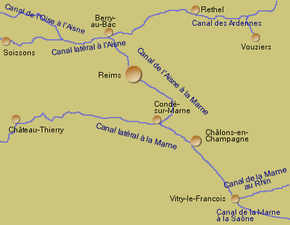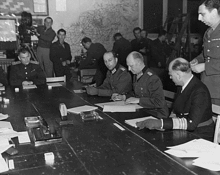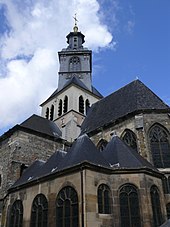Reims
![]()
The title of this article is ambiguous. For other meanings, see Reims (disambiguation).
Reims (![]()
![]() [ʀɛ̃s], German also [ʁaɪ̯ms]), formerly also spelled Rheims, is a city in Champagne in northeastern France, about 130 kilometres from Paris.
[ʀɛ̃s], German also [ʁaɪ̯ms]), formerly also spelled Rheims, is a city in Champagne in northeastern France, about 130 kilometres from Paris.
Reims is the seat of the sub-prefecture of the arrondissement of Reims in the department of Marne in the Région Grand Est. The city is the seat of an archbishop and has had a university (again) since 1971. Champagne is produced in Reims, as well as textiles, foodstuffs, and space equipment. The history of the city dates back to before Roman rule.
Approximately 220,000 people currently live in the Reims Métropole commune, and around 290,000 people live in the metropolitan area of the city, which has a total of 175 communes.
Geographical location and climate
| Rheims | ||||||||||||||||||||||||||||||||||||||||||||||||
| Climate diagram | ||||||||||||||||||||||||||||||||||||||||||||||||
| ||||||||||||||||||||||||||||||||||||||||||||||||
| Monthly average temperatures and precipitation for Reims
Source: wetterkontor.de | ||||||||||||||||||||||||||||||||||||||||||||||||||||||||||||||||||||||||||||||||||||||||||||||||||||||||||||||||||||||||||||||||||||||||||||||||||||||||||||||||||||||||||||||||||||||||||||||||||||||||||||||||||||||||||||||
Reims is in the centre of Champagne, which occupies the wide, flat-stepped eastern part of the Paris basin. The city is situated on a plain on the right bank of the Vesle, a tributary of the Aisne, and on the Canal de l'Aisne à la Marne. To the south and west rises the Montagne de Reims. The grapes from the vineyards there are used to make Champagne. Part of the Montagne de Reims is part of the Montagne de Reims Regional Nature Park.

Reims in the regional canal system
History
Roman times
The area of Reims has been inhabited since the earliest times; thus, Bronze Age urnfields can be found in the surrounding area. "According to legend, Rheims was founded by Remus, brother of Romulus, founder of ancient Rome. The inhabitants of the region therefore took the name of Rèmes." However, the Celts actually founded an urban settlement (oppidum) around 80 BC, which they called Durocorter - "round castle". The Romans first Latinized this name to Durocortorum. After the Roman conquest in the Gallic War, the city was renamed Civitas Remorum and was the capital of the Roman province of Belgica, named after the Remans, the sub-tribe of the Belgians loyal to Rome who lived here. The privileges the city received for its loyalty contributed to its prosperity.
The area was Christianized in late Roman times and the town was declared an episcopal see. In 336, the Roman governor Jovinus defeated so-called barbarians after they had invaded Champagne. In 356, the Battle of Reims took place against an Alamannic army.
Medieval
The city was at the centre of European history for centuries. Around 401, a church was built by Bishop Nicasus; the later saint died during the Vandal assault on the city in 406. In 451 the Huns under Attila conquered the city, but withdrew after the battle of the Catalaunian Fields (not far from Reims). Clovis I was baptized in the city's cathedral by Bishop Remigius between 497 and 499, which became decisive in the building of the Frankish Empire. The importance of the city, which soon also became the seat of an archbishop, is also shown by the fact that it was the residence of a partial kingdom during the Merovingian divisions of the empire.
In the 8th century, the Frankish king Pippin the Younger met with Pope Stephen III in Reims, and later Pope Leo III met with Charlemagne. The first coronation took place in Reims in 816, when the Frank Louis the Pious, appointed co-emperor by his father Charlemagne while he was still alive, was crowned emperor there once again by Pope Stephen IV after Charlemagne's death. The kings Charlemagne I († 771), Louis IV. († 954) and Lothar († 986) were buried in the Basilica Saint-Remi.
In the 10th century, Archbishop Adalberon was instrumental in the transfer of the French regency from the House of the Carolingians to the Capetians. He also ensured, together with Gerbert of Aurillac, that the city, with its cathedral school, became an intellectual centre of the early Middle Ages. Rheims remained the city where French kings were anointed and crowned from the 12th to the 19th centuries; a deliberate continuation of the tradition begun by Clovis. It had a high symbolic significance, for example, when the French under Joan of Arc succeeded during the Hundred Years' War in pushing back the English, who had occupied the north of the country, and reconquered Rheims, where Charles VII could then be crowned in 1429. City rights are documented for Reims since 1139. As an important market of the Champagne region, Reims also had some economic importance.
Modern Times
A rebellion of the burghers against the levying of the salt tax was put down by Louis XI in 1461. In the Huguenot Wars, the city was on the side of the Catholic League from 1585, but submitted to King Henry IV in 1590. The prosperity of the city, which was mainly based on the wool industry, was shown, among other things, in the construction of representative city palaces during the absolutist period.
As a result of the French Revolution, the province of Champagne was dissolved and Reims was assigned to the new department of the Marne. Napoleon's coronation, unlike that of the French kings, did not take place in Reims, but in Paris. In early 1814, the Reims area was fiercely contested before Napoleon abdicated. In the middle of the 19th century, the medieval defensive wall was demolished. Gradually industrialisation set in, and in 1854 the railway reached Reims. In 1870/71, the Prussians made Reims the seat of a governor-general, and the city suffered heavy tributes.
From 22 to 29 August 1909, Reims was the scene of the first international flying week, during which Louis Blériot, Hubert Latham and Henri Farman set several records.
World wars and reconstruction
During the First World War, the city, which had about 120,000 inhabitants in 1914 and was located almost directly behind the front line, was devastated by about 60%, mainly by German but also French artillery shells and air raids. In March 1918, most of the civilian population was evacuated. On 17 January 1919, the Comtesse de Mun launched the "Back to Reims" (Retour à Reims) campaign, whereby returning needy people could obtain mattresses, furniture and linen free of charge. Wealthy people could rent furniture for three months. The "Back to Reims" campaign also ran four public canteens. In July 1919, Reims was declared a "martyr city" (ville martyre) on the occasion of a visit by French President Raymond Poincaré. Only 25,000 inhabitants had been able to reestablish themselves in the ruined city.
As early as 1915, the city leaders of Reims began to think about reconstruction. In April 1920, the new government elected in 1919 under Mayor Charles Roche adopted an ambitious plan for reconstruction drawn up by US army major Georges B. Ford. Reconstruction (la reconstruction) of the city center took place in the 1920s in the Art Deco style. The reconstruction of Reims turned the city into a single construction site for years, first with the construction of public buildings and commercial buildings and the repair of houses that could still be "saved". This was followed by the complete rebuilding of entire streets. The reconstruction of the residential buildings was essentially completed around 1930, that of the cathedral only in 1938, that of the Saint-Remi basilica in 1958 and that of the bell tower of the Church of Saint James in 1994. On 7 May 1945, Colonel General Alfred Jodl signed the unconditional surrender of the German Wehrmacht in Reims, at the then headquarters of General Dwight D. Eisenhower, Commander-in-Chief of the SHAEF. Also in Reims, the reconciliation meeting between President Charles de Gaulle and Konrad Adenauer took place in 1962.
The tomb of Edouard Marius Ivaldi nearby is the only surviving individual war tomb.

German surrender on May 7, 1945

The reconstruction of the destroyed bell tower of St. Jacob's Church was not completed until 1994.

Reims in 1916
,_Die_Kathedrale_von_Reims.jpg)
Domenico Quaglio: Reims Cathedral in the first third of the 19th century

The sarcophagus of Flavius Iovinus from the Saint-Remi museum, third century
Search within the encyclopedia